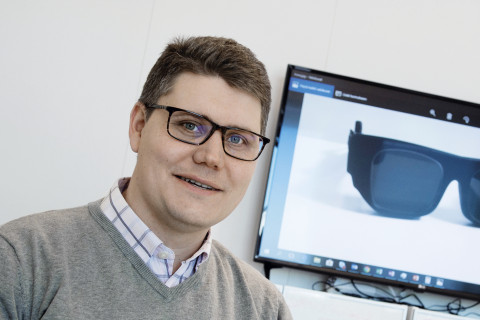Founded a couple of years ago, Dispelix manufactures consumer-grade smart glasses that look and feel exactly like normal eyewear. The spin-off company is experiencing heavy growth, with several University of Eastern Finland alumni on the staff.
“Thanks to advances in the field’s product development, Dispelix emerged as a spin-off from VTT Technical Research Centre of Finland, and they needed a little boost. We founded the company in 2015 following a New business from research ideas project funded by the Finnish Funding Agency for Innovation, Tekes. Some of the world’s largest companies became interested in our product, so we really got a running start there,” says Professor Jyrki Saarinen from the Department of Physics and Mathematics.
“Last year, our company was listed among the 50 most promising start-ups in the world, and so far we’re the only Finnish company on that list.”
Dispelix currently employs several University of Eastern Finland alumni, most of them at the company’s office in Espoo. The company was also quick to open another office on Joensuu Science Park, currently employing a total of 15 people.
“I obtained my PhD in nanofabrication from the University of Eastern Finland, and then moved to the Microsoft HoloLens team working in Espoo. I participated in the design of the first published release, and now I’m back in Joensuu again,” says Petri Stenberg, Site Manager of the Dispelix Joensuu office.
“We seek to make thin, light, ergonomic and affordable products available to consumers,” Stenberg and Saarinen say.
“This can be done with today’s technology, but it’s not easy. Currently, we can do things at a single-atom precision,” Stenberg explains.
“Mass production constitutes the biggest challenge for display technology,” says Saarinen, who has also gained experience in the display technology business thorough his other company, Heptagon.
“There are several ways of manufacturing things. I’m interested in how to produce thousands or even millions of devices, and not just focus on prototypes with fancy and expensive design.”
The sector is currently growing rapidly, so there is no time to waste, as big players are already joining in the competition.
“We are looking to introduce our product to the consumer market in a couple of years’ time. The Microsoft HoloLens now costs some 3,000–3,500 euros, but the price of our product will only be a fraction of that. We tailor our smart glasses to customer needs. First we make a master and then a mould to make copies. The material of the product can be glass or plastic, for example,” they say.
“However, this is more than just a new product; this is an entirely new technology.”
For Dispelix, the opportunity to rent the university's devices is crucial, as the company doesn’t have to purchase any pieces of equipment on its own. Moreover, product development no longer requires massive mainframe computers, as everything can be done on a laptop.
Saarinen sees smart glasses as a clear continuum of smartphones.
“This is why all the world’s major electronics manufacturers are investing in this technology. Smart glasses are expected to become the next norm, just like mobile phones used to be,” he says.
Smart glasses will also revolutionise work. For example, they will make it possible for less educated people to do demanding maintenance work.
“As always, it is difficult to predict consumer behaviour. In any case, we are dealing with a technology that will change the world.”
Photo caption: Petri Stenberg and smart glasses.
